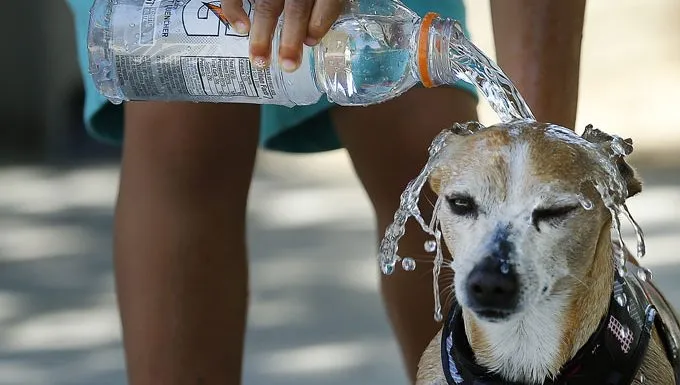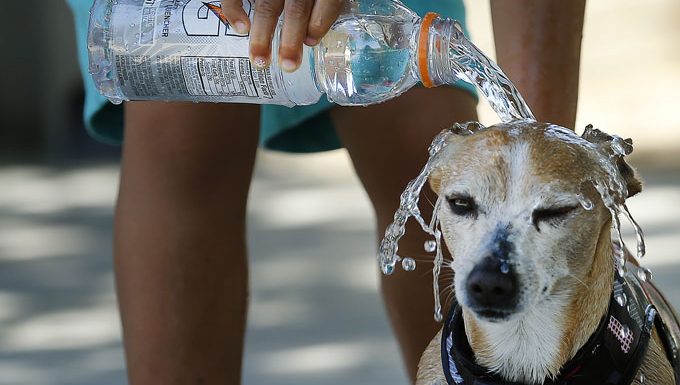
As warmer summertime temperatures approach, it’s important to remember that dogs are vulnerable to injuries and illnesses related to hot weather. In summer, dogs are more at risk for conditions like dehydration, sunburn, foot pad burns, and heat stroke.
Heat stroke, which can cause organ failure, seizures, brain damage, hemorrhages, blindness, convulsions, and even death, may be the most dangerous condition you have to worry about for your dog.
Here’s what you should know about heat stroke in dogs and how you can prevent it this summer.
Heat Stroke Starts With Heat Exhaustion

Heat stroke and heat exhaustion are dangerous situations for any dog. Heat exhaustion is generally the early stages when a dog begins overheating.
You can often remedy the effects by taking immediate action to reduce the animals’ body temperature and prevent the more deadly heat stroke.
Heat exhaustion symptoms can include:
- Diarrhea
- Nausea and vomiting
- Rapid panting
- Reddening skin inside the ears
If you see these symptoms, get your dog inside quickly to a cooler area, like a basement or near a fan, and offer fresh water. Dampen their skin with lukewarm water and allow it to air-dry.
Heat Stroke: The Symptoms & The Dogs Who Are At Risk

Heat stroke occurs when dogs’ normal body mechanisms cannot keep body temperature in a safe range. Dogs sweat only through their paws, and panting can’t always fully cool a dog down when they are overheated.
A dog’s normal body temperature is 100 to 102.5 degrees. A body temperature over 106 degrees is deadly and calls for immediate veterinary assistance.
Signs of heat stroke include:
- Rapid panting
- Bright red tongue
- Red or pale gums
- Thick, sticky saliva
- Depression
- Weakness and dizziness
- Vomiting – sometimes with blood
- Diarrhea
- Shock
- Coma
Any pet who cannot cool off is at risk for heat stroke, but some breeds and dogs with certain conditions are more susceptible. Heart disease, obesity, older age, or breathing problems put the dog at higher risk, and for these animals, even normal activities in intense heat can be harmful.
Dogs with shorter snouts, like Pugs or Bulldogs, have a harder time panting out their body heat, and certain breeds don’t tolerate the heat as well as others. This group includes English and French Bulldogs, Boxers, Saint Bernards, Pugs, and Shih Tzus.
6 Ways To Protect Your Dog From Heat Stroke In Summer

What can a pet parent do to prevent heat stroke danger? Be smart and proactive!
Here are six ways you can help your pet maintain their body temperature and avoid heat stroke in summer:
- 1. When the temperature is high, don’t let your dog linger on hot surfaces like asphalt and cement. Being so close to the ground can heat their body quickly and is also an invitation for burns on sensitive paw pads. Keep walks on these surfaces to a minimum.
- 2. Giving your dog a lightweight summer haircut can help prevent overheating, but never shave to the skin. Dogs with long coats should have at least one inch of fur protection to prevent sunburns.
- 3. Provide access to fresh water at all times. Make certain an outside dog has access to shade and plenty of cool water.
- 4. Restrict exercise when temperatures soar, and do not muzzle your dog because it inhibits their ability to pant.
- 5. Many dogs enjoy a swim, splashing in a wading pool, or a run through a sprinkler in warmer weather. This can help bring body temperatures down.
- 6. Never leave your pet in a parked car, not even if you park in the shade or plan to be gone for only a few minutes. The temperature inside of a car can reach oven-like temperatures in just minutes, often in excess of 140 degrees. That quick errand can turn into a disaster and could be fatal for your pet.
What Should You Do If Your Dog Is Suffering From Heat Stroke?

If you suspect your dog is suffering from heat stroke, fast action might save their life.
Remove the dog from the hot area immediately. Wet them thoroughly with cool to room temperature water and increase air movement around them with a fan.
Do not use ice or very cold water: it can be counterproductive since cooling too quickly can trigger other life-threatening conditions. Allow free access to water, but don’t force the animal to drink — they may inhale it or choke.
Even if the dog seems to be recovering, take them to the veterinarian as soon as possible. Dehydration is just one complication of heat stroke that the veterinarian will need to address.
The first priority will be lowering the body temperature to a safe range, and the animal may be given fluids and oxygen. A pet brought in for heat stroke should be monitored for shock, respiratory distress, kidney failure, and heart abnormalities and treated accordingly.
Your doctor may take blood samples, since clotting problems are a common complication of heat stroke. Dogs who’ve suffered from heat stroke once increase their risk of doing so again, so steps to prevent it must be taken. For them, hot and humid days will always pose a greater danger.
If any of the organs such as the heart, lungs, liver, or kidneys have been severely harmed during the heat stroke, the consequences may be irreversible.
Dogs are, by nature, protective of their humans. Responsible pet parents must return the favor by protecting their pets from the dangers of excessive heat so they can safely enjoy the welcome warmth of the summer season.
Do you keep your dog safe in summer? Got any tips for keeping dogs cool and hydrated? Let us know in the comments below!









